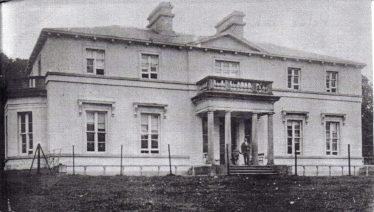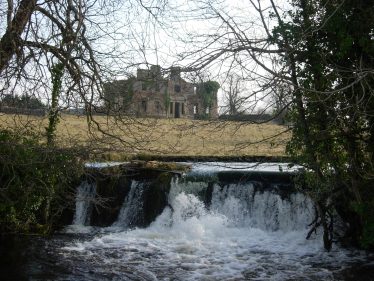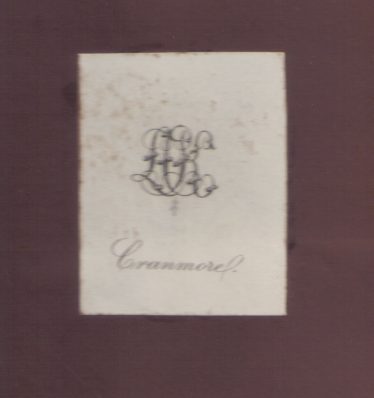Cranmore House (Ruin)

-374x249.jpg)


This once lovely house was built in 1838 for Alexander Clendenning Lambert, who was an agent for the Knox family, and had connections with the Clendenning Banking Family. The house was designed in the Palladian style (a European architectural style derived and inspired by the designs of the Venetian architect Andrea Palladioby) by architect George Papworth. Clendenning had leased the land from Colonel Charles Nesbit Knox of Castle Lacken, which was near Killala. It had an imposing main entrance from Bowgate Street with service entrances from the Neale Road.
Interior
The beautiful house had a drawing room, dining room, library, morning room and study and seven bedrooms with dressing rooms. There were kitchens and ancillary rooms in the basement. It also had a dome with gallery and extensive gardens.
Change of ownership
Cranmore House reverted to the Knoxes immediately after the Famine and was used as a dower house by Colonel Charles Howe Cuff Knox for his mother initially.
The Knox family were originally from County Donegal and in 1778 William Knox married Elizabeth Nesbitt of Scurmore, county Sligo. Their son Charles Nesbitt Knox married Jane Cuff, eventually heiress to the settled estates of her father James Cuff, Lord Tyrawley of Ballinrobe.
Col. Charles Knox, born in 1817-1867, was the only son of Charles Nesbitt Knox and Jane Cuff and the first member of the Knox family to actually live in Ballinrobe at Cranmore. He married Lady Louisa Browne (1816-1891) sister of the Marquis of Sligo in 1839. There is a beautiful stained-glass window to their memory in the former Church of Ireland, St. Mary’s, now and the current library. Col. Knox was High Sheriff of Co. Mayo in 1860 and Colonel in the North Mayo Militia. Their children were:
1. Charles Howe Cuff Knox (1841-1921) married Henrietta Elizabeth Gibson-Craig on 30 September 1869. He was Captain 8th Hussars and Honour Colonel 3rd Battalion Connaught Rangers (d. Dec 1921) and lived at his new Creagh House after 1875. There is a stained-glass window “In memory of Charles Howe Cuff Knox who died 27th Dec. 1921 aged 81 years” in the Church of Ireland (now the Library)
2. Howe James 1843-1910, lived at Cranmore House
3. Hubert Thomas b 1845 – 1921, lived at Cranmore House
4. Philippa 1848-1921 lived at Cranmore House
Their eldest son (no 1 above) Charles Howe Cuff Knox built Creagh House around 1875. He was a Justice of the Peace (J.P), Deputy Lieutenant (D.L.) and High Sheriff of Co. Mayo in 1873 having a M.A. from Oxford. He was Colonel of the 3rd battalion of the Connaught Rangers and Captain of the 8th Hussars.
He married Henrietta Elizabeth, daughter of Sir William Gibson Craig of Scotland, and their children, whom I have listed to avoid confusion between the two families were:
Charles W. Cuff Knox (b 1870-1910), lived at Creagh House. He was a Major in the Rifle Brigade and died on 25th January, 1910 aged 39 years. There is a stained-glass window on the left side of the Church of Ireland (now the Library) in his memory.
Henry Howe Cuff Knox (b 1871-1954), lived at Creagh House.
Gerard Knox b. 1874, lived at Creagh House and Louisa Gertrude d. 1954 married Captain Walter Charles Lascelles, son of the Rev. Hon James Walter and Emma Clara Miles in 1902.
Hubert Thomas (no 3 above) 1845-1921 their 3rd son was a well known historian and author of History of the County Mayo from the earliest times to the close of the 16th century, see bibliography. He was also a member of the Royal Society of Antiquaries of Ireland and was elected a fellow of the in 1886; he made many contributions to their Journals http://www.rsai.ie/ He also wrote articles for the Galway Archaeological and Historical Society http://www.gahs.info/
Philippa, (no 4 above) their daughter contributed to the Association for the Preservation of the Memorials of the Dead, Ireland Journal for the year 1892 and to further publications up to 1910, see http://www.tcd.ie/Library/ where she records some of the gravestone from St. Mary’s Church of Ireland, Ballinrobe.
Census
Howe James Knox was Head of Household in the 1901, with 5 servants Bridget Stritch, (60 years) Cook, Adele Delmire (70), Ladies maid, Lillie Woods (25) Parlour maid, Jane Cook (19), Housemaid and Delia Finnerty (18) Kitchen maid.
Visitors to Cranmore
According to the Ballinrobe Chronicle the Lord Lieut. Earl Spencer was received at Cranmore on the 4th Sept. 1869.
Later occcupiers
Many years later c 1920’s Cranmore House was purchased by the Patrick Daly, whose brother Dr. Peter practised medicine from there, and also held the post of workhouse Doctor. After the Workhouse (see No 3 Town Heritage Trail) closed he moved to London. Dr. Peter remembers Col. Knox and corresponded with him when there was a family bereavement c 1921.
Cranmore House was then sold to the McCartan family in the 1940’s. The gate lodge still remains standing close to the main entrance gates.
In due course the house was sold by the McCartan family and the new owner removed the roof to avoid payment of the high rates (a form of property tax) in the early 1950’s. Many of the beautiful trees were removed and sold.
This entrance was the original entrance to a tower-house which was then extended as a Manor House and finally as a Cavalry Barracks.
Outbuildings
The gate-lodge is still on the outside right of the gate and further along the street on the left side towards Main St. one can still see the cut stone coach houses with their high surrounding walls, occupied by Vet. Rory O’Neill’s and Kelly’s practice [now Paul Cummins’]. A harness room, laundry and dog kennels were also located here. A cobblestone yard suitable for horses was later covered over.
Patsy Murphy of Cornmarket recalls playing in Cranmore as a child and observed a row of bells in the lower level kitchen used to summon the servants.
No 03 on the Town Heritage Walk

Comments about this page
I remember Lizzie Glendenning living on Creagh Road in the 50s/60s.
Editor: Thank you Bernard and its an interesting gem of information.
Add a comment about this page